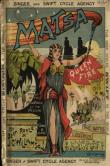Although set mostly in Egypt (with scenes of the pyramids, Cairo, and Ancient Memphis), this original fairytale nevertheless concludes with a scene set in Australia: Melbourne or Sydney, depending on where it was being produced.
The story concerns a beautiful young princess's rescue (by her beloved prince) from a sacrifice at the hands of Matsa, the evil Queen of Fire (who demands the life of a maiden every hundred years). The Fates point to Zelica as the victim and dispatch Pentaur (a revived mummy) to modern Cairo to seize her. Pentaur's attempt is foiled by Colonel Boomley (an American speculator) and Prince Simbal (Captain of the Khedive's Guard), but he manages to trick them into eating the magic apples of Isis the Great, which somehow send them back to Memphis of 3000 years ago, a time when Rameses III ruled Egypt. Zelica is eventually saved, but not before several grand adventures occur, including the group's capture by pygmies. Secondary characters incorporated into the narrative include an ugly Irish spinster and an American heiress, along with warriors, priests, and others. The Sydney Morning Herald critic notes that although 'the comic element in Matsa is not strong... there are some clever lyrics in the libretto... Much [of the production's success, however] is due to the grace and gaiety of the music' (29 February 1897, p.7).
The production included the usual Williamson spectacles: grand marches, sumptuous ballets, and elaborate and striking costumes. Some notable features of the production were 'The Mist of Past Ages', 'Ancient Memphis Restored', 'The Tomb of the Kings', 'The Triumphant Return of Rameses III', 'The Great Martial Procession' (comprising some 250 people), 'The Land of the Pygmies', 'Matsa's Cyclopian Guards', 'March of the Elephants, Lions and Tigers and Other Animals', 'The Home of the Queen of Fire', 'Sensational Fire Ballet', 'On a P and O Steamer in the Suez', 'The Court of the Queen of Air', and the 'Astounding Ariel Ballet.'
The visual highlight of the production, according to one review, were George Gordon's scenes 'The Rising of the Nile' and the 'Startling Inundation Scene', which show the destruction of Matsa's temple by an inundation of the Nile. 'The priestesses,' records one critic, 'are seen dancing in the fire, until overwhelmed by the water. The massive temple sinks bit by bit, the Nile rises higher and higher, and at last the stage 'looks like a vast extent of water shimmering under a full moon' (Sydney Morning Herald 2 January 1897, p.4).
 8694090965410005247.jpg
8694090965410005247.jpg
 Matsa, Queen of Fire ; Or, The Apples of Isis, the Dates of Osiris, and the Little People of the Mountains of the Moon, Onn and Oph
single work
pantomime
fantasy
-
Three acts.
Matsa, Queen of Fire ; Or, The Apples of Isis, the Dates of Osiris, and the Little People of the Mountains of the Moon, Onn and Oph
single work
pantomime
fantasy
-
Three acts.

